Ratibida columnifera
upright prairie coneflower
An upright, clump-forming perennial to 80cm tall, with finely cut, feathery leaves. From early summer to early autumn, slender, branching stems bear daisy-like flowerheads to 8cm across, with drooping red or yellow (sometimes red and yellow) ray florets around a large, columnar cone
Synonyms
Ratibida columnarisSize
Ultimate height
0.5–1 metresTime to ultimate height
1–2 yearsUltimate spread
0.1–0.5 metresGrowing conditions
Moisture
Well–drainedpH
Alkaline, NeutralColour & scent
| Stem | Flower | Foliage | Fruit | |
| Spring | Green | |||
|---|---|---|---|---|
| Summer | Red Yellow | Green | ||
| Autumn | Red Yellow | Green | ||
| Winter |
Position
- Full sun
Aspect
South–facing or West–facing
Exposure
ShelteredDrought resistance
Yes Hardiness
H6Botanical details
- Family
- Asteraceae
- Native to GB / Ireland
- No
- Foliage
- Deciduous
- Habit
- Columnar upright
- Genus
Ratibida are biennials or perennials with erect stems developing from woody-based crowns. The flowers have colourful, outer ray florets and a tall, central boss of green, then brown, disc florets
- Name status
Correct
- Plant range
- S.W. Canada, W. and C. USA to New Mexico
How to grow
Cultivation
Grow in well-drained, neutral to slightly alkaline, moderately fertile soil in full sun. Drought resistant once established
Propagation
Propagate by seed or division
Suggested planting locations and garden types
- Cottage and informal garden
- Gravel garden
- Prairie planting
- Cut flowers
- Flower borders and beds
Pruning
No pruning required
Pests
Generally pest-free
Diseases
Generally disease-free
Get involved
The Royal Horticultural Society is the UK’s leading gardening charity. We aim to enrich everyone’s life through plants, and make the UK a greener and more beautiful place.
